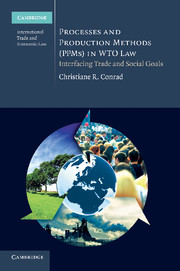Book contents
- Frontmatter
- Contents
- List of figures and tables
- Preface and acknowledgements
- Table of GATT 1947 Reports
- Table of WTO Reports
- List of abbreviations
- Introduction
- I Foundations: the relevance of NPA measures at the interface of domestic regulation, economic globalization and world trade law
- 1 Setting the stage for legal analysis
- 2 Putting the debate into perspective: analysis of the socio-economic context
- II Legal analysis: reviewing the status of NPA measures de lege lata
- III Outlook: new perspectives on the legal status of NPA measures
- Summary and concluding remarks
- Bibliography
- Index
2 - Putting the debate into perspective: analysis of the socio-economic context
Published online by Cambridge University Press: 05 June 2011
- Frontmatter
- Contents
- List of figures and tables
- Preface and acknowledgements
- Table of GATT 1947 Reports
- Table of WTO Reports
- List of abbreviations
- Introduction
- I Foundations: the relevance of NPA measures at the interface of domestic regulation, economic globalization and world trade law
- 1 Setting the stage for legal analysis
- 2 Putting the debate into perspective: analysis of the socio-economic context
- II Legal analysis: reviewing the status of NPA measures de lege lata
- III Outlook: new perspectives on the legal status of NPA measures
- Summary and concluding remarks
- Bibliography
- Index
Summary
NPA measures pose a multidimensional problem. At first glance, NPAs are a subject of domestic regulation, and as such part of the internal affairs of any given state. But if NPA measures apply to goods, then in the case of imported goods they automatically refer to activities and conditions located within another country, namely, the country of production. Due to international trade, NPA measures are inherently linked to subjects usually considered to fall into the internal affairs of other states. This means that beyond WTO law, NPA measures touch upon the concept of national sovereignty, which is a key concept of international relations and public international law. More than that, NPA measures have effects upon trade and businesses. Such effects are economic by nature, and they may constitute the very purpose of the measure or merely a side-effect. The WTO Agreements are based on economic rationales, and hence the economic effects of NPA measures cannot be ignored in assessing their permissibility under WTO law.
Domestic regulation, for example, regulation of production, can take many forms. First, regulation of production may be direct regulation through prohibitions, obligations or requirements. Direct regulation of production, however, is limited to production inside the regulator's jurisdiction. Second, production can be influenced through regulation which applies to a product, but is linked to the way in which it has been produced.
- Type
- Chapter
- Information
- Processes and Production Methods (PPMs) in WTO LawInterfacing Trade and Social Goals, pp. 64 - 114Publisher: Cambridge University PressPrint publication year: 2011



